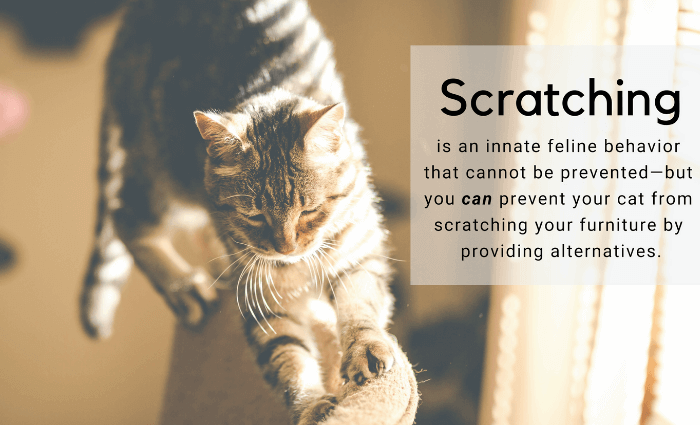When it comes to frustrating feline behaviors, a penchant for furniture destruction tops the list for most owners. These tips and creative solutions can help your cat develop better scratching habits so you can live in harmony—and maybe even save your favorite chair in the process.
Understand Your Cat's Need to Scratch
Whether we like it or not, scratching is an innate feline behavior that cannot be prevented—in fact, even declawed cats still “scratch!”
While it may be tempting to scold your cat the next time he sinks his nails into your couch, remember, he’s not acting out of spite. Scratching provides exercise, anxiety relief, and a good stretch—not to mention it keeps kitty’s claws in top shape. Instinctively, cats also scratch to mark their territory and communicate with other cats.

Teach Him What Not To Scratch
Behavior modification consists of teaching your cat to avoid certain scratching sites while helping him to enjoy scratching on appropriate surfaces. It is always best to develop good habits early, but don’t let that discourage you—retraining is possible, even in senior cats!
Show your cat which areas are off-limits by making them less inviting. Consider temporarily covering furniture with double-sided sticky tape or aluminum foil, or spritzing your cat’s favorite scratching spots with an unpleasant scent, like citrus, or a deterrent spray.
Provide (Many) Alternatives
Discouraging your cat from scratching unwanted surfaces is only half the battle. You must also bring in appropriate alternatives for him to scratch, like carpeted cat trees, sisal rope scratching posts, or simple cardboard or wood planks.
Remember that every cat’s scratching preferences are different, so the first step will be figuring out what your cat likes. Ultimately, you will want to provide alternatives that most closely resemble the unwanted objects your cat loves to scratch.
Watch his behavior closely—does he like to scratch the seat of your armchair or does he prefer the wooden legs of your dining room table? This can provide valuable clues about his preferences, which you can use to successfully redirect his habits.
If you’re not sure, start by offering multiple scratching materials and experimenting with different sizes, angles, and locations.

Make It Appealing
Encourage your cat to scratch on appropriate surfaces by making them irresistible. If your cat seems uninterested in the scratching options you’ve provided, try placing catnip, toys, or treats near or on the scratching surface. If he scratches or paws at the surface, quickly reward him with a treat.
Here at The Drake Center, we recommend using a pheromone product called Feliscratch to help direct your cat toward designated scratching surfaces—and away from your household furnishings.
Go to the Source
Another way to deter your cat’s destructive scratching is to trim his nails. Start slowly by introducing your cat to having his paws handled. At a time when your cat is calm and relaxed, gently touch his feet and press on each paw pad to extend the nail. Practice this process frequently, only doing as much as your cat will tolerate. It may take a week or two before your cat becomes comfortable enough to allow nail trimming.
When you are both ready, place your cat on your lap facing away from you or enlist a friend to hold your cat while you trim. Gently extend each nail, trim the tips, and repeat every two weeks. It is important to only trim the white tips—the pink portion of each nail contains the quick, which is made up of nerves and blood vessels that cause bleeding and discomfort when cut.
Once you and your cat are accustomed to the process, it should be relatively short and painless; however, if either of you are uncomfortable, you can always leave it to a veterinary or grooming professional—or consider covering your cat’s nails instead. Most pet supply stores carry Soft Paws, which are small vinyl caps that adhere to your cat's claws. The caps are safe, easy to apply, and will protect your furniture for four to six weeks at a time.
Still struggling with scratching issues? Contact us or schedule an appointment to discuss additional treatment options and next steps to correct this unwanted behavior.

